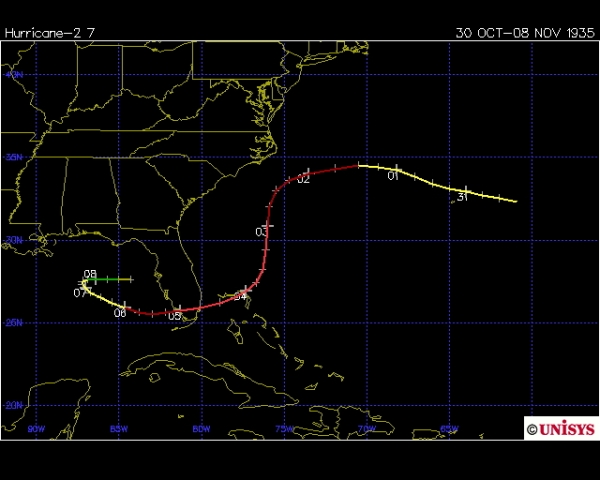
On November 4, 1935, a hurricane slammed into Miami, Florida from an unexpected quarter. The storm moved in from the northeast, unusual in most cases and the only November hurricane to strike Miami from that direction. It was dubbed the “Yankee” hurricane because it came from the north, as many “snowbirds” did at that time of year.
The storm developed from a cut-off extratropical low east of Bermuda. Sitting over warm waters for a long period of time, convection developed near the center of the circulation and led to the development of tropical characteristics. A large, high-pressure ridge to the north of the system pushed the tropical storm westward very near Bermuda. As it approached North Carolina, the system deepened into a hurricane by Nov. 1st. By the next day, the storm veered southwest away from Cape Hatteras and made a southerly track toward the Bahamas under the influence of another high-pressure ridge over the Eastern Seaboard. The system continued to deepen and reached its peak strength with maximum sustained winds estimated at 105 mph (165 km/hr).
By Nov. 4th, the hurricane reached the southern side of the ridge and began to curve westward over the northern Bahamas and toward south Florida. It caused considerable flooding in the islands that led to 14 deaths. The winds diminished slightly before the hurricane struck the northern Miami Beach area with 98 mph (157 km/hr) winds. About three feet of storm surge came over Miami Beach and downtown Miami, flooding streets. The winds shattered plate-glass windows in the shopping district and unroofed houses in Dade and Broward Counties. Construction standards had been raised after the Great Miami hurricane of 1926 and damage was only US$5.5 million. Because of the extensive warnings issued prior to landfall, only five deaths occurred in Florida.
The hurricane crossed over the peninsula in eight hours and entered the Gulf of America much weakened. It drifted out into the eastern Gulf over the next two days slowly waning, and once the ridge that had driven it westward moved away it began to move back toward Florida. But it dissipated before making another landfall.